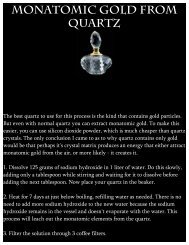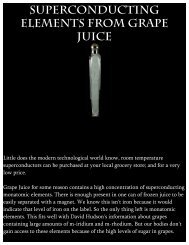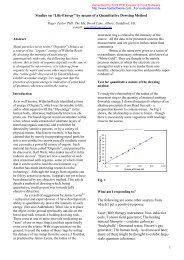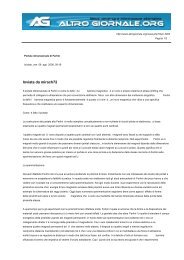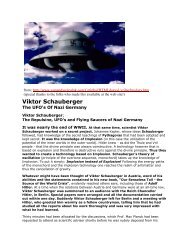Planck's Constant as a Dimensionless Gravitational Fine Structure ...
Planck's Constant as a Dimensionless Gravitational Fine Structure ...
Planck's Constant as a Dimensionless Gravitational Fine Structure ...
- No tags were found...
You also want an ePaper? Increase the reach of your titles
YUMPU automatically turns print PDFs into web optimized ePapers that Google loves.
Planck’s <strong>Constant</strong> <strong>as</strong> a <strong>Dimensionless</strong> <strong>Gravitational</strong> <strong>Fine</strong> <strong>Structure</strong> <strong>Constant</strong>Phil Russell, §* Jerry Montgomery †‡§ Phil Russell, North Carolina Central University, NC, 27707† Willowstick Technologies LLC, Draper, UT 84020(Dated: 20 April, 2007)The fine structure constant [4] characterizes the strength of the electromagneticinteraction. It is a dimensionless quantity. The following is a common derivation.2α e−31= = 7.2973525376(50) × 10 =4πεħc137.035990679(94)(1)0In equation (1), e is the elementary charge, ħ = h /( 2π) is the reduced Planck’sconstant, c is the speed of light in a vacuum, andε 0is the permittivity of free space.Our empirical equation [2] is consistent within the framework of currenttheoretical and phenomenological constraints such <strong>as</strong> general relativity and the Pioneereffect [3], respectively. Acceleration due to energy is expressed <strong>as</strong> quantized by thefollowing expression:a = 〈 h〉νc(2)The dimensionless constant 〈h〉acts <strong>as</strong> the unit of proportionality between theacceleration (or observable) a and the frequency of a photonν multiplied by c the speedof light in a vacuum. It is equivalent in magnitude to Planck’s constant in equation (3).−34h = 6 .62606896(33) × 10 J ⋅ s(3)−34〈h〉= 6.62606896(33) × 10(4)The only difference being, <strong>as</strong> we have stated, that it is unit-less. We can also writeequation (2) more explicitly <strong>as</strong>:2ca = 〈 h〉(4)λ_________________*Electronic address: Prussel3@mail.nccu.edu‡ Electronic address: jrm@willowstick.com1
The wavelength of a photon is given by λ , which gives us the proper units foracceleration in m/s 2 .It may be possible to consider the constant (4) <strong>as</strong> characterizing the strength of thegravity interaction. Following equation (1) <strong>as</strong> a template, we might derive the following:〈 h〉=aλc11.50919045×10−34β = = 6.62606896(33) × 10 =(5)233We believe that such a relationship is not unre<strong>as</strong>onable, and lies within the realm oftheoretical and phenomenological considerations.References[1] Link for the original empirical equation, “Electromagnetic gravitation”:http://adsabs.harvard.edu/abs/2005APS..MAR.R1197M[2] Link for “Study of the anomalous acceleration of Pioneer 10 and 11”:http://arxiv.org/PS_cache/gr-qc/pdf/0104/0104064v5.pdf[3] Link for the “Pioneer Effect”:http://www.groupkos.com/eso/tiki-index.php?page=Electromagnetic+Gravitation[4] Link for the “<strong>Fine</strong> structure constant”:http://en.wikipedia.org/wiki/<strong>Fine</strong>_structure_constant2



